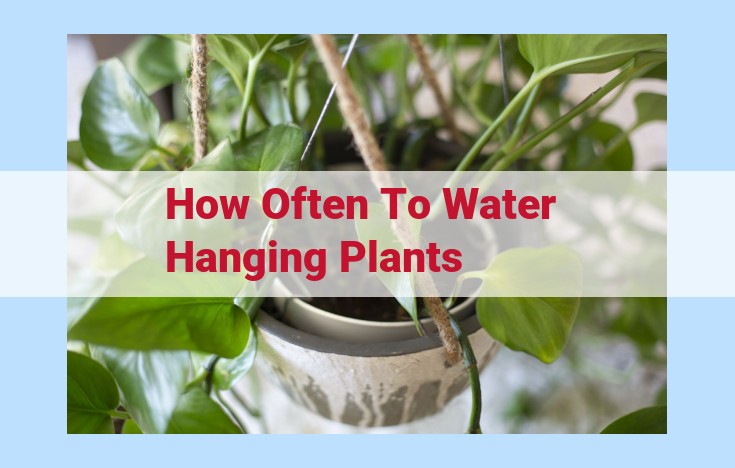Optimal Watering Guide For Healthy Plants: Prevent Waterlogging And Ensure Root Health

- Water when the soil surface is dry to the touch.
- Water thoroughly, allowing excess to drain from the bottom of the pot.
- Empty the saucer under the pot to prevent waterlogging.
Essential Factors for Plant Watering: A Comprehensive Guide to Keep Your Plants Thriving
Watering plants at the right time and in the right amount is crucial for their health and well-being. Understanding the essential factors that influence plant watering is key to maintaining a lush and vibrant indoor or outdoor garden.
Watering Frequency: How Often Should You Water?
The optimal watering frequency depends on plant species, pot size, and environmental conditions. As a general rule, allow the top inch or two of soil to dry out before watering again.
Watering Methods: How to Get Water to Your Plants
There are several methods you can use to water your plants effectively:
- Hand-watering: Using a watering can or hose, gently pour water onto the soil surface, avoiding the leaves.
- Drip irrigation: A system that delivers water directly to the plant’s roots, reducing water evaporation.
- Wicking: Using capillary action, wicks in the soil pull water up from a reservoir below.
Water Types: What Water is Best for Your Plants?
- Filtered or rainwater: Free of impurities, these water sources are ideal for most plants.
- Tap water: May contain chemicals like chlorine or fluoride, which can be harmful to plants. If using tap water, let it sit overnight to dissipate any gases.
Watering Tools: The Right Tools for the Job
Different watering tools are designed for specific purposes:
- Watering cans: Ideal for small- to medium-sized plants, allowing for controlled watering.
- Spray bottles: Used for misting foliage, especially for plants that prefer high humidity.
Soil: How It Affects Watering Needs
Soil characteristics significantly impact watering frequency:
- Drainage: Well-draining soil allows excess water to escape, preventing waterlogging and root rot.
- Texture: Sandy soil drains quickly, while clay soil retains water for longer.
Drainage: Why It’s Essential
Proper drainage ensures that excess water doesn’t accumulate around the plant’s roots, leading to root rot. Ensure pots have drainage holes and consider using raised beds or containers with good drainage.
Monitoring: Checking Soil Moisture
Monitoring soil moisture is crucial to avoid over- or under-watering:
- Finger test: Insert your finger into the soil up to the first knuckle. If it feels dry, it’s time to water.
- Moisture meter: An electronic device that measures soil moisture levels.
Additional Factors Affecting Watering Needs
Beyond the essential watering factors, various other aspects can influence a plant’s hydration needs. Here are some key considerations to help you tailor your watering practices:
Sunlight Exposure
Sunlight plays a crucial role in plant water loss through evaporation. Higher light intensity and longer exposure lead to increased evaporation rates. Consequently, plants in areas with bright, direct sunlight may require more frequent watering than those in shaded or low-light environments.
Humidity
Humidity, or the amount of moisture present in the air, also affects water loss. Lower humidity levels promote faster evaporation from plant leaves, necessitating more frequent watering. Conversely, in high humidity environments, evaporation is slower, allowing plants to retain water for a longer period.
Temperature
Temperature influences plant metabolism, which in turn affects water absorption and loss. Higher temperatures increase water uptake and transpiration (loss of water through plant leaves). Therefore, during warmer weather, plants may require more watering to offset the increased water use.
Pot Size
The size of the pot can significantly impact watering needs. Larger pots hold more soil and water, allowing for less frequent watering. On the other hand, smaller pots dry out faster, necessitating more frequent watering to keep the soil moist.
Specific Plant Considerations
Every plant has unique watering needs, and understanding these requirements is crucial for their well-being. Here are specific watering instructions for five popular houseplants:
Ferns
Ferns thrive in humid environments with moist soil. Water regularly to keep the soil evenly damp but not soggy. Brown leaf tips indicate underwatering, while yellowing leaves suggest overwatering.
Pothos
Pothos is known for its forgiving nature when it comes to watering. It can tolerate occasional underwatering or overwatering. However, optimal growth requires watering when the top 1-2 inches of soil feel dry to the touch.
Spider Plants
Spider plants have relatively low watering needs. Allow the top inch of soil to dry out before watering. Avoid overwatering, as this can lead to root rot. Yellowing leaves may indicate overwatering, while wilting can signify underwatering.
Philodendrons
Watering requirements vary among philodendron species. Thicker-leaved varieties, such as Philodendron hastatum, need less water than thinner-leaved varieties like Philodendron erubescens. Generally, water when the top inch of soil is dry to the touch.
ZZ Plants
ZZ plants are renowned for their drought tolerance. Water infrequently, only when the soil is completely dry. Overwatering can cause root rot, so it’s better to err on the side of underwatering.